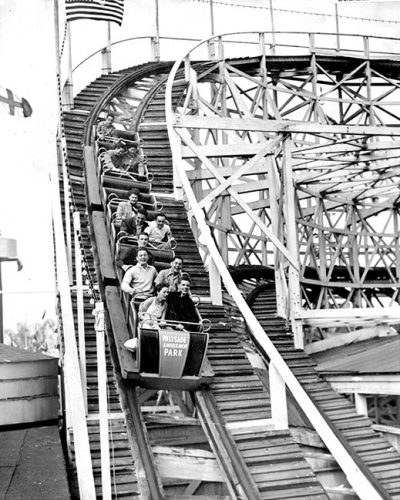
The TV commercials played in such heavy rotation amid the after-school cartoons of the 1960s that the bouncy jingle is still lodged in the deepest crevices of many a middle-aged Jerseyan’s brain. “Palisades has the rides, Palisades has the fun,” it went. “Come—On—Over.”
The ads pestered kids to pester their parents to take them to Palisades Amusement Park, which was not in its namesake town, but straddled the line between Fort Lee and Cliffside Park, perched atop the Hudson River bluffs half a mile south of the George Washington Bridge. It was a giddily improbable but resplendent playland of roller coasters, penny arcades and an immense saltwater pool.
“The Ferris wheel was right by the cliffs, and when you were on it you felt like you were much higher than you really were, because you were also looking down another 200 feet to the river,” says Vince Gargiulo, 63, the founder and executive director of the Palisades Amusement Park Historical Society and author of a book about the park. “But my favorite spot was the entrance on Palisades Avenue, because you knew everything was going to start from there.”
The site opened in 1898 as a trolley park to encourage people to use the trolley on weekends, it included a park with rides, an athletic field and a Hudson River view. It soon grew into a permanent carnival that rivaled Coney Island. Dirigible flights, Wild West shows, Italian operettas, Siamese twins, two-headed cows, the tunnel of love, high-diving horses, french fries doused with malt vinegar, radio broadcasts by Cousin Bruce Morrow, a stage where acts from Xavier Cugat to Diana Ross performed—it was all there on 38 acres bristling with an ever-shifting array of entertainment.
“It got so popular, there was no way that little two-town area could support that many vehicles coming in,” says Gargiulo, who often walked the 15 blocks from his Cliffside Park home to Palisades as a boy. “I remember the traffic jams, and I remember my father coming up with new curse words when he was trying to get from one end of town to the other.”
At its peak, the park hosted more than 100,000 people a day. It was an especially electric sight from across the river at night, the lights twinkling dreamlike atop the cliffs.
“That was his inspiration,” Gargiulo says about Chuck Barris, who was a young ABC television employee, not yet the producer of The Dating Game or The Gong Show, when he glanced across the Hudson and heard a tune in his head. “He saw the amusement park across the river and he started writing the song.”
In 1962, Barris’s tune, “Palisades Park,” was a number-3 hit for Freddy “Boom Boom” Cannon. But by 1972, the saltwater pool was dry and the Cyclone roller coaster was a pile of timber. The land was rezoned, the park replaced by a cluster of condominium towers. A small monument stands as a memory. “Here we were happy,” declares the bronze plaque affixed to a boulder, “here we grew!”
